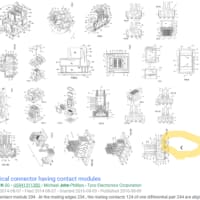US2022245769
[0002] This disclosure relates generally to generative adversarial networks (GANs) and, in non-limiting embodiments,
【0002】
本開示は一般的には、敵対的生成ネットワーク(GAN:generative adversarial network)に関し、
a system and method for removing noise and/or artifacts from an OCT image and/or segmenting ocular layers of an OCT image using a GAN.
及び非限定的実施形態では、GANを使用することによりOCT画像から雑音及び/又はアーチファクトを除去する及び/又はOCT画像の眼球層を分割(セグメンテーション、分離)するためのシステム及び方法に関する。
/////////////
[0040] Attempts to use a GAN to remove speckle noise in retinal OCT images have relied on an absence, or limited amount of, eye motion between frames during image capture.
【0034】
網膜OCT画像内のスペックル雑音を除去するためにGANを使用する試みは、画像捕捉中のフレーム間の眼球運動がないこと又は制限された量に依存してきた。
The ground truth data for such a GAN was generated using a compounding technique in which the same tissue area was imaged multiple times, and individual volumes were registered yielding averaged B-scans for training.
このようなGANの正解データは、同じ組織エリアが複数回撮像され及び個々のボリュームが登録され、それにより訓練するための平均化されたBスキャンを提供する複合技術を使用することにより生成された。
However, this proposed methodology to generate ground truth data for training is not feasible as corneal datasets exhibit large motion when acquired in-vivo, which makes registration and compounding technologically challenging, resource intensive, and potentially inaccurate.
しかし、正解データを生成するためのこの提案方法論は、角膜データセットが生体内で取得される際に大きな運動(登録及び複合化を技術的に挑戦的、資源集約的、且つ恐らく不正確にする)を示す(exhibit)ので実現可能ではない。
In addition, existing research databases, from which corneal datasets can be extracted for use in algorithmic development, rarely contain multiple scans of the same tissue area for compounding.
加えて、角膜データセットがアルゴリズム開発における使用のために抽出されることができる既存研究データベースは、複合化のための同じ組織エリアの複数回スキャンをめったに含まない。
US2020167591
[0018] FIG. 8B illustrates a ground truth edge map for the central patch of FIG. 8A according to embodiments.
図8Bは、実施形態に係る図8Aの中心パッチに関するグランドトゥルース(正解データ)エッジマップ。
///////
A ground truth image may be a highly accurate image against which other images (e.g., from image processing methods) are compared.
グランドトゥルース画像は、(例えば、画像処理方法からの)他の画像を比較するための非常に正確な画像である。
WO2018098039
[0014] The present disclosure illustrates various techniques and configurations that enable enhanced training of machine learning networks through user actions that occur in respective workflows at multiple, distributed locations.
【0007】
本開示は、複数の分散された場所において各ワークフローで行われるユーザアクションを通じて機械学習ネットワークのエンハンスされた訓練を可能にする各種技術及び構成を示す。
Such workflows include clinical workflows that are undertaken by medical professional users within medical information processing settings.
このようなワークフローは、医療情報処理設定内で医療専門家のユーザによって行われる診断ワークフローを含む。
The techniques and configurations disclosed herein may be used to identify differences from a machine learning model that have been applied, modified, or rejected within a clinical workflow, including differences that occur within respective workflows for clinical users who are distributed across a large network of medical facilities.
ここに開示される技術及び構成は、医療施設の大規模なネットワーク全体に分散化された資料ユーザのための各自のワークフロー内で行われる相違を含む診断ワークフロー内において適用、修正又は拒絶された機械学習モデルから相違を特定するのに利用されうる。
The resulting differences that are identified from the various workflow uses of the model may be collected and processed as training data (e.g., reinforcement or correction data) for the machine learning model—
モデルの各種ワークフローの利用から特定される結果としての相違は、機械学習モデルの訓練データとして収集及び処理されてもよく(例えば、強化又は正解データ)、
thus, improving future iterations and applicability of the machine learning model.
従って、機械学習モデルの将来的なインタラクション及び適用可能性を向上させる。
US2019032151
[0534] Algorithms for the detection and classification of IHC-stained objects on a whole slide basis were written in Matlab.
[0461] 全スライドに基づく、IHC染色した物体の検出及び分類のためのアルゴリズムは、Matlabにおいて執筆された。
Following brightfield stain unmixing, IHC-stained objects were detected as cell candidates.
明視野染色分離の後、IHC染色した物体を細胞候補として検出した。
For all cell candidates, quantitative features were extracted.
全ての細胞候補について、定量的特徴を抽出した。
Candidates were then classified into the various cell classes (e.g. CD8+ /Ki67− cells) using supervised machine learning.
その後、教師あり機械学習を使用して、候補を様々な細胞クラス(例えば、CD8+ /Ki67− 細胞)に分類した。
The classification method was trained using a ground truth gallery of true and false stained objects (provided by a pathologist).
(病理学者によって提供される)真及び偽の染色した物体の正解データギャラリーを使用して、分類方法を訓練した。
US10835210
[0046] While the data does not represent a bounding box, the bounding box is positioned based on the object represented by the data and/or other features represented by the data.
【0043】
データが境界ボックスを表していない際には、そのデータによって表される対象物および/またはその他の形状物に基づいて、境界ボックスが配置される。
In one embodiment, a machine-learnt classifier locates the bounding box.
一実施の形態では、機械学習分類子によって境界ボックスの位置が特定される。
Experts annotate training data with bounding boxes.
熟練者によって、複数の境界ボックスの注釈が付けられる。
The machine training then learns the position of the bounding box based on the ground truth in the training data representing scans of patients.
そして、機械学習訓練では、訓練データにおける患者のスキャン結果を表す正解データに基づいて、境界ボックスの位置を学習する。
The machine learns to position the bounding box given data representing the patient.
その機械学習では、患者を表す所与のデータに境界ボックスの位置を決定することを学習する。
The processor locates the bounding box using the matrix or matrices of the machine-learnt classifier.
プロセッサは、機械学習分類子の単数または複数のマトリックスを用いて境界ボックスの位置を特定する。
The distinguishing features used to locate the bounding box may be other than features of the object of interest.
境界ボックスの位置を特定するために用いられる際立った特徴は、関心対象物とは異なったものであり得る。
EP3990658
Since high linking accuracy is confirmed,
高いリンク精度が確認されているため、
it is suspected that
the mixed-species multiplets detected by sequencing but not imaging are
シーケンシングでは検出されたがイメージングでは検出されなかった混合種マルチプレットは、
because of the imperfections in scRNA-seq data, which serves as the ground truth.
正解データ(ground truth)として機能するscRNA-seqデータの不完全性が原因である
と考えられる。
US7877722
[0122] The die may have many examples of a particular context so there may be adequate samples of the particular context for training the classifier.
【0100】
ダイには、特定のコンテキストの例が多数ありえるので、分類子をトレーニングするための特定のコンテキストの適切なサンプルがある。
In addition, the misclassification rate of the classifier may be determined since it is possible that many contexts are indistinguishable to the inspection systems (i.e., the images of the contexts may appear substantially similar in feature space).
さらに、多くのコンテキストが検査システム(つまり、コンテキストの画像は、特徴空間で本質的に類似したように見えてもよい)に対して区別不能であることがありえるので、分類子の誤分類率が決定できる。
The features used in the classifier may be the raw pixel data or signals themselves or features derived from the raw pixel data or signals such as features used in iADC to classify the background.
分類子の中で使用される特徴は、生の画素データ、あるいは信号自身あるいは生の画素データから派生した特徴、あるいは、背景を分類するためにiADCの中で使用される特徴のような信号でありえる。
The “ground truth” or “true classification” is provided by the design context.
「正解データ」あるいは「真分類」は、設計コンテキストによって提供される。
The granularity (“context cell”) of the design context may be relatively coarse (e.g., about 1 μm by about 1 μm) or relatively fine (e.g., about 0.1 μm by about 0.1 μm or about 1 to 2 design rules in size).
設計コンテキストの粒度(「コンテキストセル」)は、比較的粗い場合もあるし(例えば、約1μmx約1μm)、あるいは比較的細かい場合もある(例えば、約0.1μmx約0.1μmあるいは約1~2設計規則サイズ)。
*Ground truth:
1)教師あり学習において「一つ一つのデータに対して付与される正解」「これは犬です」「これは猫です」
「ラベル(labels:正解ラベル、Ground Truth:正解、教師データ:labeled training data)とは?」@IT, AI IoT, Deep Insider, AI・機械学習の用語辞典
2)「AI モデルの出力の学習やテストに使用される実際のデータを表す用語」、機械学習やディープラーニングの出力を実環境と照合しながらのテスト、MathWorks
学習データ:
training data:(モデルやプログラムの性能を改善する過程において機械学習モデルやプログラムを学習させる(訓練する)ためのデータ)
learning data:(上記の意味で使ってもOK?)
US2020342267(JP、既出)
[0085] In order to improve recognition accuracy for the rare case in the recognizer, increasing the ratio of the data of the rare case in the learning data is considered. However, in actuality, it is difficult to collect a large amount of data of the rare case.
【0069】
認識器においてレアケースについての認識精度を向上させるためには、学習データ中のレアケースのデータの割合を増やすことが考えられるが、実際にレアケースのデータを大量に収集するのは困難である。
The “learning data” is data for learning in which an input signal used in learning is associated with a supervisory signal indicating a correct answer label corresponding to the input signal, and is also called “training data”.
「学習データ」は、学習に用いる入力信号と、その入力信号に対応した正解ラベルを示す教師信号とを関連付けた学習用のデータであり、「訓練データ」とも呼ばれる。
機械学習、Wikipedia(既出)
機械学習(きかいがくしゅう、英: machine learning)とは、経験からの学習により自動で改善するコンピューターアルゴリズムもしくはその研究領域で[1][2]、人工知能の一種であるとみなされている。「訓練データ」もしくは「学習データ」と呼ばれるデータを使って学習し、学習結果を使って何らかのタスクをこなす。例えば過去のスパムメールを訓練データとして用いて学習し、スパムフィルタリングというタスクをこなす、といった事が可能となる。
訓練データを使ってプログラムの性能を改善する過程を、「プログラムを訓練する」もしくは「プログラムを学習させる」という。
Ground Truth, Wikipedia
"Bayesian spam filtering is a common example of supervised learning. In this system, the algorithm is manually taught the differences between spam and non-spam. This depends on the ground truth of the messages used to train the algorithm – inaccuracies in the ground truth will correlate to inaccuracies in the resulting spam/non-spam verdicts."
Ground Truth in Machine Learning: Importance and 7 Key Challenges
What is Ground Truth?, datagen
"in an image classification system, the algorithm learns to classify each image into a set of classes (e.g., cat, dog, sheep). The algorithm trains using training data with ground truth labels indicating the true class of each object."
"In supervised learning algorithms, ground truth data is critical to training new algorithms."
"Supervised methods learn a target domain by training on large amounts of data with corresponding ground truth labels. Initially, the model trains on data with ground truth labels. When an initial version of the model is ready, it is evaluated on evaluation and testing datasets where the model does not know the ground truth label. Predictions are compared to the actual ground truth label to determine model performance."


























※コメント投稿者のブログIDはブログ作成者のみに通知されます